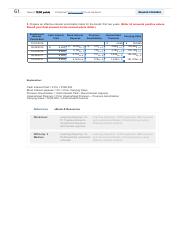
Most companies only send a customer balance or memo without listing the outstanding invoices. It’s usually in a separate document and this is confusing for your customers. This is https://www.accountingcoaching.online/ something that should be automated, ideally through a customer portal or receivable automation software. This clarifies what your customers owe you and when they need to pay you.
It aids cash management.
- Credit also builds trust and goodwill between the business and its customers, which contributes to customer loyalty and retention.
- A note receivable can be used in exchange for products and services or in exchange for cash (usually in the case of a financial lender).
- Numerous gaps in the existing processes necessitate laborious manual efforts.
- In a similar—albeit exact opposite—way, firms increase accounts receivable when revenue is earned before cash is received.
By highlighting terms in initial agreements and ongoing correspondence – which can be referenced in the event of any dispute – companies can avoid future misunderstandings. The faster companies can collect payment from customers, the sooner current and noncurrent assets: the difference they can use the resulting cash to cover operating costs, build resilience, generate returns from investment, or drive revenue growth. At Upflow, we provide solutions to help you collect customer payments effortlessly and efficiently.
What Are Accounts Receivable (AR)?
Because the customer (or debtor) has a legal obligation to pay for what they received, Accounts Receivables are considered a liquid asset. Through a process called “pledging,” businesses can even use their Accounts Receivable as collateral for a short-term or long-term loan or line of credit. Net Realizable Value of Accounts Receivable is nothing but the amount that is anticipated to be collected by the company from its customers. That is, the amount of accounts receivables expected to be converted into cash. If that is the case, Ace Paper Mills is receiving late payments from its customers. Such a credit sale is recorded as accounts receivable in your books of accounts.
Latest news
On the other hand, accounts payable refers to funds a business owes for supplies, software, contract labor expenses, and more. As we mentioned, receivables refer to outstanding balances due to a company for providing goods or services on credit. Businesses will use accounts receivable any time they offer a product https://www.personal-accounting.org/cash-conversion-score-for-cloud-companies/ or service for a customer on credit. Firms may use AR to allow customers to utilize a product or service upfront and pay later as a sales tactic for high-ticket items. Finally, days-sales-outstanding is calculated as the average number of accounts receivables divided by sales and then multiplied by 365.
Done effectively, it can be just as valuable a lever as accounts payable when it comes to building a strong working capital position. These reasons are that it’s time-consuming, it’s a complex and tedious process that businesses don’t want to handle it. By making this mistake and removing the operational complexity, you are also losing out on the opportunity to create and foster a strong customer relationship.
This in turn means you can be far more efficient when it comes to collecting your payments. Small businesses can manage accounts receivable by issuing invoices promptly, setting clear payment terms, actively pursuing collections, and regularly reviewing key performance metrics. An aging report categorizes accounts receivable by the length of time an invoice has been outstanding.
That way, customers will be less likely to dispute the payment or forget all about their interaction with you. Companies get paid faster when customers can have transparent access to their account, view invoice statuses, and easily make online payments. Organizations that still rely on manual invoicing techniques—and subsequently maintain poorer AR management processes—limit their cash flow and growth. Keeping timely, accurate transaction and payment records is central to accounts receivable management, too. Doing so ensures account balances are up-to-date and makes account reconciliation smoother. An effective accounts receivable management system also strengthens your business’s reputation and builds strong relationships with customers by ensuring their payment experiences are memorable and easy.

And, AR staff can ensure compliance and mitigate risk through better fraud detection and maintaining internal controls. Further, it also measures how efficiently you as a business use your assets. Thus, Accounts Receivable Turnover is a ratio that measures the number of times your business collects its average accounts receivable over a specific period. In short, AR management is concerned with expediting the process of collecting outstanding customer payments.
Keeping your finances on track and staying on top of your accounts receivable (AR) is important for healthy cash flow in a small business. Effective accounts receivable management involves managing and tracking outstanding customer invoices and ensuring timely payment collection. These AR management software tools go beyond automating manual tasks, to relieve significant pain around wasted time, underutilized talent, delayed payments, and customer miscommunications. Accounts Receivable (AR or A/R), sometimes called “receivables,” is how companies ensure, receive and process customer payments. In general accounting, Accounts Receivable is the money owed to a business for goods and services delivered but not yet paid for, i.e. purchased by customers on credit. After the sale is made and products are delivered, AR sends the invoice and processes the customer payment.
When a credit card is accepted, it means that the credit card company (e.g., VISA, MasterCard, or American Express) will guarantee the payment. The cash will be deposited in the merchant’s bank account in a very short period of time. Accounts receivable refers to the money that customers owe a company for services or goods received.
When you know that a bill will not be paid, you reclassify the receivable balance to bad debt expense. Accounts receivable balances that will not be collected in cash should be reclassified to bad debt expense. You may have some uncomfortable conversations, but it’s better to have them sooner than later.

It also includes tools for streamlining accounting tasks, like the invoice process, and gaining insight into your business’s financial health. Every business should maintain a written procedures manual for the accounting system, and the manual should include specific procedures for managing accounts receivable. A procedures manual ensures that routine tasks are completed in the same manner each time, and the manual allows your staff to train new workers effectively and effortlessly. Net credit sales means that all returned items are removed from the sales total. An average accounts receivable is the (beginning balance + ending balance)/2.
In addition to these core topics, we also include an FAQ section that answers some of the most common questions asked about AR management. Our goal is to provide you with a thorough understanding of every aspect of AR, so you can approach your accounts receviable management with confidence and clarity. The information contained in the invoice is essential to both the business and the customer and contains all the vital information related to the transaction. Most AR teams must navigate a patchwork of legacy systems, reports, spreadsheets, and tools to retrieve data and complete work. Siloed, hard-to-find data prevents learning from real-time and historical data. As per Accrual System of Accounting, you record Allowance for Doubtful Accounts so that you get an understanding of the amount of bad debts that can occur in future.

If you’re diligent in the collection process, you can avoid hiring a collection agency or an attorney to pursue collections on your behalf. You can use a number of strategies to increase cash collections and reduce your receivable balance. The accounts receivable ageing schedule separates receivable balances based on when the invoice was issued. The cash is received in April, but the revenue is correctly recorded in March. Using accounts receivable posts the revenue in the month earned, and your accounting records are consistent with the accrual basis. Business.com aims to help business owners make informed decisions to support and grow their companies.
The advantages of accounts receivable automation extend beyond simply streamlining the process; it also enables organizations to effectively monitor invoicing, collections, and emerging patterns. Furthermore, this automation empowers employees to redirect their attention towards more strategic endeavors, ultimately fostering business growth and success. Inefficient management of cash flow, inadequate customer support, and excessive focus on cash application can have a cascading impact on your team’s performance. Streamlining invoicing processes can prevent billing errors and ensure invoices reach customers. Use tools that facilitate easy invoice sending and enable direct payments. To effectively address the evolving complexity of your AR processes, meticulous planning and strategic resource allocation are imperative.